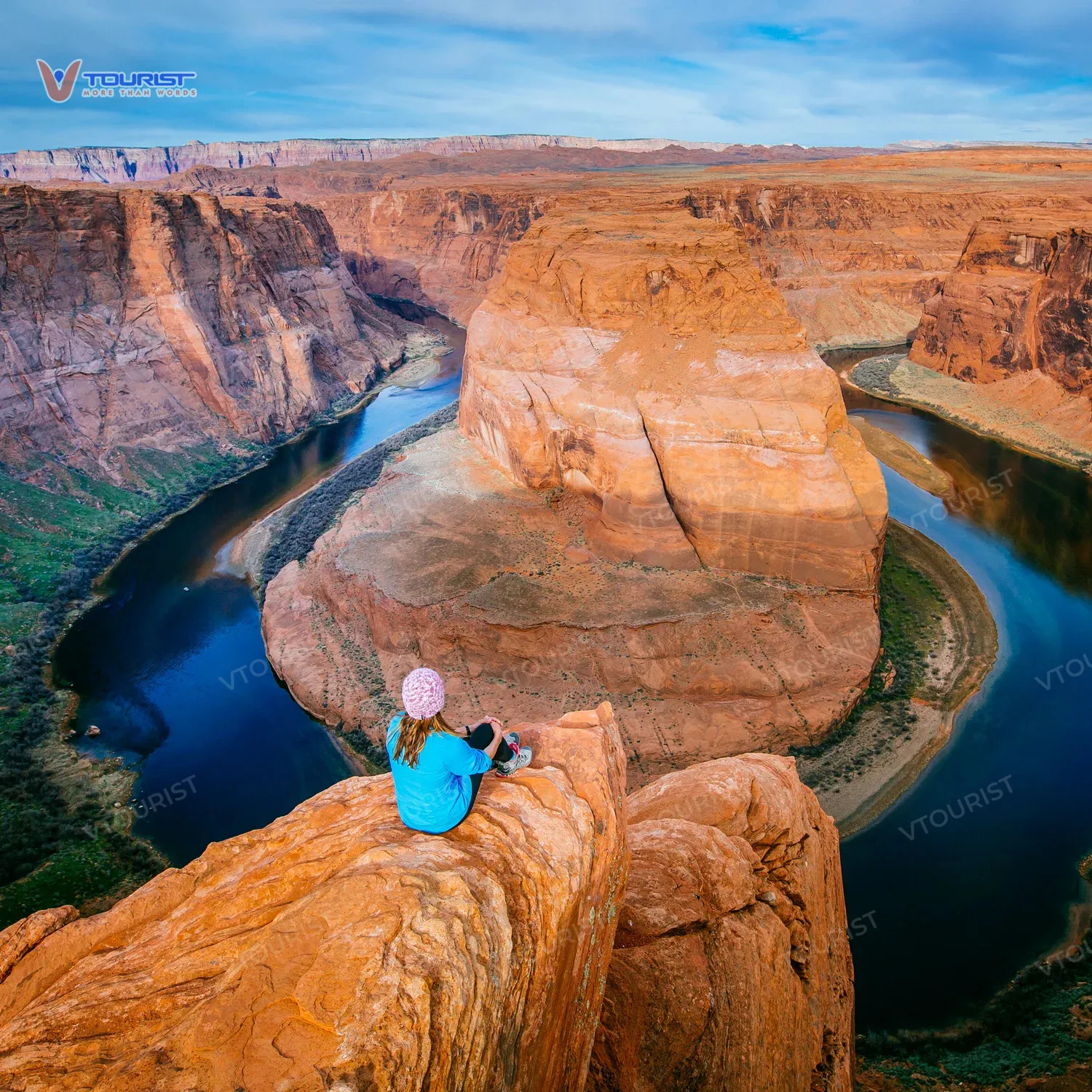Beyond its sprawling deserts, Arizona harbors unique natural wonders, most notably Horseshoe Bend. This horseshoe-shaped canyon is a vivid testament to the Colorado River’s power over millions of years. Join “Du lịch khắp thế gian” to explore the majestic beauty of Horseshoe Bend and the captivating sights along the Colorado River, fully immersing yourself in the raw and alluring charm of this region.
Horseshoe Bend: A Horseshoe-Shaped Masterpiece by the Colorado River
Horseshoe Bend, a breathtaking meander of the Colorado River, lies nestled within the arid desert of Arizona. Originating in the Rocky Mountains, the Colorado River has tirelessly sculpted this natural masterpiece, carving into the earth to create towering cliffs that encircle a perfectly formed horseshoe bend.

Horseshoe Bend’s allure lies not only in its distinctive shape but also in the harmonious blend of earth tones and river hues. The vibrant red sandstone cliffs, formed over millions of years, starkly contrast with the emerald green of the Colorado River, creating a dynamic and mesmerizing natural tableau. Standing atop the nearly 300-meter-high cliff, visitors are enveloped by a sense of awe and grandeur, humbled by the beauty of creation.
Journey Along the Colorado River: From Past to Present
The Colorado River is more than just a vital water source for the Southwestern United States; it’s a historical witness to the region’s formation and evolution. Exploring the Colorado River is a journey back in time, delving into geological transformations, ancient civilizations, and modern marvels.
Cliffs Telling Tales of Geological History
The cliffs surrounding Horseshoe Bend are colossal geological storybooks, chronicling Earth’s formation over millions of years. The red sandstone layers, composed of sand and minerals deposited in arid environments since the Tertiary period, have undergone compression and solidification, resulting in unique rock patterns.

Erosion from water and wind has sculpted peculiar shapes on the cliff faces, creating a landscape that is both visually stunning and scientifically significant. Studying Horseshoe Bend’s geology enhances our understanding of Earth’s history and past climate changes.
Glen Canyon Dam: A Symbol of Engineering and Progress
Not far from Horseshoe Bend stands Glen Canyon Dam, a colossal engineering feat built on the Colorado River. Glen Canyon Dam is not just a symbol of modern construction prowess but also plays a crucial role in providing water and energy to the region.

Completed in 1966, Glen Canyon Dam is 216 meters high and 300 meters long, creating Lake Powell, one of the largest artificial lakes in the United States. From atop the dam, visitors can admire panoramic views of Lake Powell and the surrounding red rock mountains, forming a magnificent and majestic vista.
Must-See Attractions Near Horseshoe Bend
The area around Horseshoe Bend boasts numerous other captivating attractions, promising visitors diverse and memorable experiences.
Antelope Canyon: The Magical Canyon of Light
Just a 15-minute drive from Horseshoe Bend, Antelope Canyon is a narrow slot canyon renowned for its stunning light beams and dramatic rock formations. The undulating sandstone walls, eroded by water and wind, create bizarre and unique shapes.

Sunlight filtering through the canyon’s narrow opening creates shimmering, ethereal light shafts, transforming Antelope Canyon into a paradise for photographers and nature enthusiasts.
Lake Powell: A Water Recreation Paradise
About a 30-minute drive from Horseshoe Bend, Lake Powell is a vast artificial lake offering numerous recreational activities such as boating, fishing, swimming, and waterskiing. Visitors can rent boats or join boat tours to explore Lake Powell’s beauty and the surrounding sandstone canyons.
Grand Staircase-Escalante National Monument: Land of Geological Wonders
Approximately a 1.5-hour drive from Horseshoe Bend, Grand Staircase-Escalante National Monument is a sprawling national park celebrated for its diverse landforms and majestic scenery. Visitors can explore deep canyons, towering cliffs, and pristine forests, embracing the raw and tranquil beauty of this region.
Best Time to Explore Horseshoe Bend and the Colorado River
The ideal times to visit Horseshoe Bend and explore the Colorado River are during spring (March – May) and autumn (September – November). During these seasons, the weather is mild and pleasant, avoiding the intense summer heat and the colder winter months. Sunlight also creates stunning color effects on the cliffs and the river.
Sunrise and sunset are the most enchanting times of day to admire Horseshoe Bend. The soft light of dawn and dusk accentuates the vibrant colors of the sandstone layers, creating a romantic and unforgettable scene.
Important Notes for Visiting Horseshoe Bend
- Bring plenty of water: Especially during summer, Arizona’s weather is hot and dry. Carrying sufficient water is crucial to prevent dehydration.
- Wear comfortable shoes: The walk from the parking lot to Horseshoe Bend is quite long and involves sand and rocks, so choose comfortable walking shoes.
- Sun protection: Don’t forget to bring a hat, sunglasses, and sunscreen to protect your skin from the sun’s harmful rays.
- Be careful when taking photos: The cliffs at Horseshoe Bend are very high and dangerous, so exercise caution when taking photos and avoid standing too close to the edge.
- Maintain environmental cleanliness: Dispose of waste properly and avoid littering to preserve the natural beauty of Horseshoe Bend.
Horseshoe Bend and the Colorado River are unmissable destinations for those who appreciate the raw and majestic beauty of the United States. Plan your trip today and discover the incredible wonders this region has to offer.